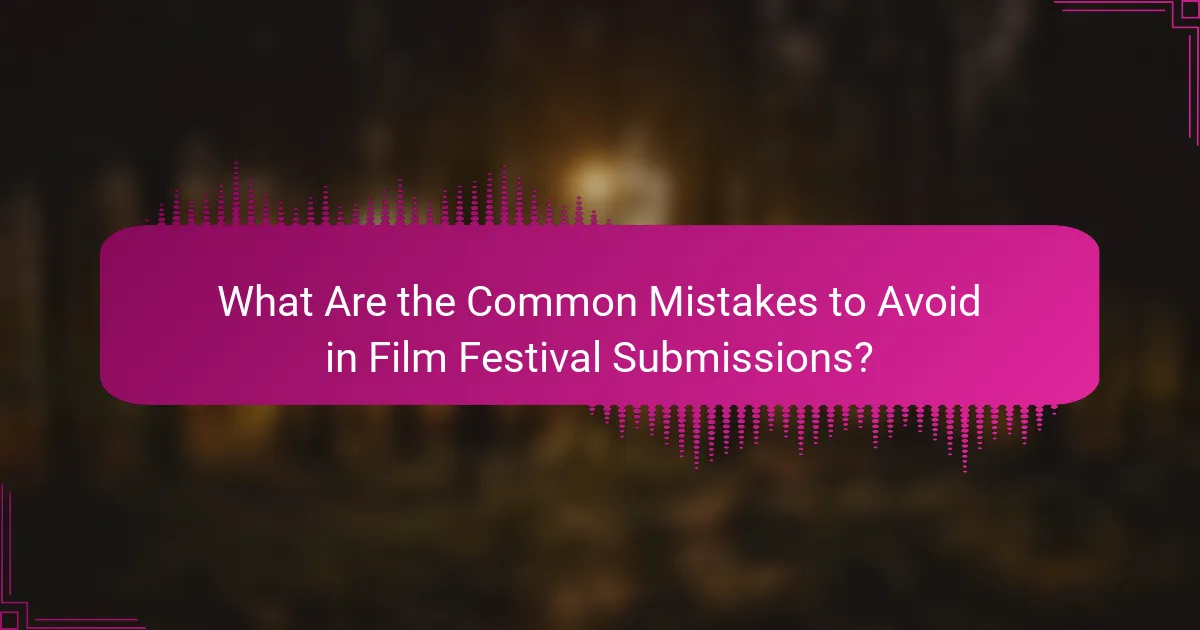Submitting to an indie film festival requires a well-crafted package that highlights your film and its creators. Key elements such as clarity, professionalism, and visual appeal are essential for capturing the attention of festival organizers and demonstrating your film’s potential audience appeal. By avoiding common submission mistakes, you can significantly enhance your chances of acceptance and ensure your work is presented effectively.

What Are the Key Elements of an Indie Film Festival Submission Package?
An indie film festival submission package typically includes several essential components that showcase the film and its creators. These elements help festival organizers evaluate the film’s suitability for screening and its potential audience appeal.
Film synopsis
The film synopsis is a concise summary of the film’s plot, usually ranging from 150 to 300 words. It should capture the essence of the story, highlight the main characters, and convey the film’s themes without revealing major plot twists.
A strong synopsis entices readers and provides a clear understanding of what to expect. Focus on clarity and engagement to make a memorable impression.
Director’s biography
The director’s biography offers insight into the filmmaker’s background, experience, and previous works. This section should be brief, ideally one paragraph, and highlight notable achievements, awards, or relevant education.
Including personal anecdotes or unique perspectives can help create a connection with the audience. Tailor the biography to emphasize aspects that align with the film’s themes or style.
Production stills
Production stills are high-quality images taken during the filming process that visually represent the film. Aim for 5 to 10 carefully selected stills that showcase key scenes, characters, and the overall aesthetic.
These images should be engaging and professionally presented, as they play a crucial role in attracting attention and generating interest in the film.
Trailer link
A trailer link provides a short preview of the film, typically lasting between one and three minutes. This video should highlight the film’s tone, style, and key moments to entice viewers and festival programmers alike.
Ensure the trailer is polished and reflects the film’s quality, as it serves as a critical marketing tool. Include a link to a reliable platform, such as Vimeo or YouTube, for easy access.
Screenplay or script
The screenplay or script is a detailed document outlining the film’s dialogue, actions, and scenes. Submitting the script allows festival judges to assess the writing quality and narrative structure.
Ensure the script is formatted according to industry standards, typically using software like Final Draft or Celtx. A well-organized and polished script can significantly enhance the overall submission package.

How to Present Your Indie Film Submission Effectively?
To present your indie film submission effectively, focus on clarity, professionalism, and visual appeal. A well-structured package can significantly enhance your chances of being noticed by festival programmers.
Professional formatting
Professional formatting is crucial for making a strong first impression. Use standard fonts like Arial or Times New Roman, and maintain consistent margins and spacing throughout your documents. Ensure that your title page includes essential details such as the film title, your name, contact information, and the film’s runtime.
Consider using a template specifically designed for film submissions. This can help you adhere to industry standards and avoid common formatting pitfalls that may distract from your content.
Clear and concise language
Using clear and concise language is essential for communicating your film’s vision effectively. Avoid jargon and overly complex sentences; instead, aim for straightforward descriptions that convey your story and themes. Each section of your submission should be easy to read and understand.
When writing your synopsis, keep it brief—typically one paragraph is sufficient. Highlight the main plot points and character arcs without delving into excessive detail. This approach helps maintain the reader’s interest and ensures they grasp the essence of your film quickly.
Visual appeal
Visual appeal plays a significant role in capturing attention. Include high-quality stills from your film that showcase key moments or themes. These images should be well-composed and relevant to the narrative you are presenting.
In addition to images, consider the overall layout of your submission package. Use headings, bullet points, and white space effectively to create a clean and organized appearance. A visually appealing package not only looks professional but also makes it easier for festival programmers to navigate your materials.

What Are the Common Mistakes to Avoid in Film Festival Submissions?
Common mistakes in film festival submissions can significantly hinder your chances of acceptance. Avoiding these pitfalls, such as ignoring guidelines and submitting incomplete packages, is crucial for presenting your film effectively.
Ignoring submission guidelines
Each film festival has specific submission guidelines that must be followed. Ignoring these can lead to automatic disqualification. Guidelines often include format specifications, runtime limits, and required materials, so always read them carefully.
To ensure compliance, create a checklist based on the festival’s requirements. This can include aspects like file formats (e.g., MP4, MOV), resolution (usually HD), and submission deadlines. Missing even one detail can jeopardize your submission.
Submitting incomplete packages
Submitting an incomplete package is another common mistake that can lead to rejection. A complete submission typically includes the film, a synopsis, director’s bio, and promotional materials like posters or stills. Omitting any of these elements can weaken your application.
Before submitting, double-check that all required components are included. Consider using a submission checklist to ensure nothing is overlooked. This not only helps in meeting festival requirements but also presents a more professional image.
Poor quality visuals
Visual quality is critical in film submissions, as it reflects the overall production value. Poorly shot or edited footage can detract from the story and make it less appealing to festival judges. Ensure your film is polished and meets industry standards.
Invest time in color grading and sound mixing to enhance the visual and auditory experience. If budget constraints exist, consider collaborating with local filmmakers or students who can provide quality work at a lower cost. High-quality visuals can significantly improve your film’s chances of being selected.

How Do Indie Film Festivals Evaluate Submission Packages?
Indie film festivals evaluate submission packages based on a combination of artistic merit, technical quality, and audience potential. Each festival may have its own specific criteria, but common elements include originality, storytelling, and production values.
Judging criteria
Judging criteria for indie film festivals typically include aspects such as narrative structure, character development, and visual style. Festivals often look for originality and creativity, assessing how well the film stands out in a crowded market. Technical elements like sound design and cinematography also play a crucial role in the evaluation process.
Some festivals may use a scoring system to rate these criteria, while others rely on qualitative assessments from panelists. Understanding the specific criteria of each festival can help filmmakers tailor their submissions effectively.
Panelist feedback
Panelist feedback is an essential component of the evaluation process, providing filmmakers with insights into their work. Many festivals offer written feedback to filmmakers, highlighting strengths and areas for improvement. This feedback can be invaluable for future projects, helping filmmakers refine their craft.
Panelists often consist of industry professionals, including directors, producers, and critics, which adds credibility to the feedback. Filmmakers should consider this feedback seriously, as it reflects the perspectives of experienced individuals in the field.
Audience engagement metrics
Audience engagement metrics are increasingly important in evaluating indie film submissions. Festivals may track viewer reactions, attendance numbers, and social media interactions to gauge a film’s potential appeal. High engagement levels can indicate a film’s ability to resonate with audiences, which is a key consideration for festival programmers.
Filmmakers can enhance audience engagement by promoting their films through social media and community outreach. Understanding how to connect with potential viewers can significantly impact a film’s success at festivals and beyond.

What Are the Costs Associated with Indie Film Festival Submissions?
The costs associated with indie film festival submissions can vary significantly based on factors like the festival’s prestige, location, and submission deadlines. Understanding these expenses helps filmmakers budget effectively and maximize their chances of success.
Entry fees
Entry fees are a primary cost when submitting to film festivals. These fees can range from around $20 to several hundred dollars, depending on the festival’s size and reputation. Some festivals offer early bird discounts, so submitting early can save money.
Filmmakers should also consider the number of festivals they plan to enter, as multiple submissions can quickly add up. It’s wise to prioritize festivals that align with the film’s genre and target audience to ensure a better return on investment.
Marketing expenses
Marketing expenses can include promotional materials, social media advertising, and press kits. A well-prepared press kit may cost between $100 and $500, depending on the quality and quantity of materials produced. Investing in marketing can significantly enhance visibility and audience engagement.
Filmmakers should allocate a budget for online promotions, especially if the festival has a virtual component. Engaging with potential viewers through social media can create buzz and increase attendance at screenings.
Travel and accommodation costs
Travel and accommodation costs are crucial considerations for filmmakers attending festivals. Depending on the festival’s location, these expenses can range from a few hundred to several thousand dollars. Booking accommodations early can often lead to better rates.
Filmmakers should explore options like shared accommodations or local hostels to reduce costs. Additionally, budgeting for meals and local transportation is essential to avoid overspending during the festival.

What Are the Benefits of Submitting to Indie Film Festivals?
Submitting to indie film festivals offers filmmakers exposure, networking opportunities, and potential distribution deals. These festivals can elevate a film’s profile, connect creators with industry professionals, and attract audiences who appreciate independent cinema.
Increased Exposure and Audience Reach
Indie film festivals provide a platform for filmmakers to showcase their work to a diverse audience. By participating, films can gain visibility that might be challenging to achieve through traditional distribution channels.
Many festivals attract industry insiders, critics, and potential investors, creating opportunities for further promotion. For example, a film that wins an award at a festival may receive invitations to additional screenings or distribution offers.
Networking Opportunities
Attending indie film festivals allows filmmakers to connect with peers, industry professionals, and potential collaborators. These interactions can lead to partnerships, mentorships, and even future projects.
Networking can happen in various settings, from formal panels to casual social events. Engaging with other filmmakers and industry representatives can provide valuable insights and open doors that might not be accessible otherwise.
Potential for Awards and Recognition
Many indie film festivals offer awards that can significantly enhance a filmmaker’s credibility. Winning or being nominated for an award can attract media attention and increase a film’s marketability.
Recognition from reputable festivals can lead to invitations to larger events or festivals, expanding a filmmaker’s reach. Additionally, awards can serve as a powerful marketing tool, helping to draw in audiences and investors.
Access to Industry Resources
Indie film festivals often provide access to workshops, panels, and resources that can benefit filmmakers. These educational opportunities can cover various topics, from filmmaking techniques to marketing strategies.
Participating in these sessions can help filmmakers refine their skills and gain insights into the industry. Many festivals also offer feedback sessions, where filmmakers can receive constructive criticism on their work, aiding in future projects.
